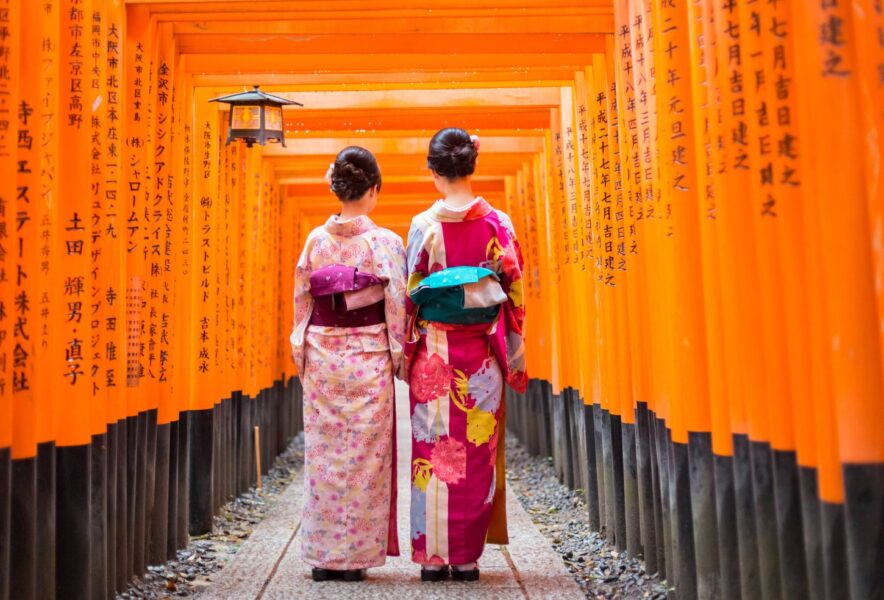Basic Differences Between Shrines and Temples
Shrines and temples are both religious sites in Japan, but they have distinct religious backgrounds and roles. Shrines are primarily associated with Shinto, Japan’s indigenous religion, whereas temples are linked to Buddhism, a religion that came to Japan via China and India. These sites are managed according to their respective religious teachings, and their structures and rituals differ accordingly.
Features and Worship Methods of Shrines
Shrines are places where Shinto deities are enshrined. Visitors enter the sacred grounds through a traditional gate called a torii. Worshippers cleanse their hands and mouths at a purification fountain (temizuya), toss a coin into the offering box, ring the bell, and perform the ritual of two bows, two claps, and one bow. Shrines emphasize harmony with nature and are often surrounded by beautiful natural environments.
Features and Worship Methods of Temples
Temples are dedicated to spreading Buddhist teachings and house statues of Buddha. Visitors remove their shoes at the entrance, ring a bell, join their hands in prayer (gassho), and chant sutras quietly. Temples also offer meditation, zazen (seated meditation), and sermons, serving as places to seek inner peace and enlightenment.
How to Distinguish Between Shrines and Temples
There are several points to help distinguish between shrines and temples.
Torii and Sanmon Gates
Shrines always have a torii gate, usually painted red or made of wood, marking their entrance. In contrast, temples have a sanmon gate, often guarded by Nio statues or stone dogs (komainu).
Building Structures
The main hall (honden) of a shrine is typically simple and wooden, designed to blend with nature. Temple main halls (hondo) are often grand and ornate, housing statues and sacred objects.
Symbols
Shrines feature shimenawa (sacred ropes), ema (wooden plaques for writing prayers), and omamori (charms). Temples display pagodas, sutras, and stone statues, with five-story pagodas and stone Buddhas being especially iconic.
Recommended Shrines and Temples to Visit in Tokyo and Their Blessings
Tokyo is home to many historic shrines and temples, each with its unique charm. Below are some notable ones and their blessings.
Shrines
- Meiji Shrine
- Blessings: Matchmaking, safe childbirth, family safety
- Meiji Shrine Official Website
- Hie Shrine
- Blessings: Business success, prosperity, warding off evil
- Hie Shrine Official Website
- Tokyo Daijingu
- Blessings: Matchmaking, romantic fulfillment
- Tokyo Daijingu Official Website
- Ueno Toshogu Shrine
- Blessings: Longevity, academic success
- Ueno Toshogu Official Website
Temples
- Senso-ji Temple
- Blessings: Ward off evil, business prosperity, family safety
- Senso-ji Temple Official Website
- Tsukiji Hongwanji Temple
- Blessings: Ancestral veneration, Buddhist connections, peace of mind
- Tsukiji Hongwanji Temple Official Website
Etiquette and Tips for Visiting
To have a deeper experience when visiting shrines and temples, it is essential to follow these etiquette guidelines.
Shrine Etiquette
- Bow once before passing through the torii gate and walk on the sides, not in the center.
- Cleanse your hands and mouth at the temizuya.
- Toss a coin, ring the bell, and pray using the two bows, two claps, and one bow ritual.
Temple Etiquette
- Remove your shoes at the entrance and move quietly.
- Ring the bell before entering the main hall, join your hands, and chant sutras.
- Respect photography restrictions if any.
Conclusion
Visiting shrines and temples in Tokyo allows you to deeply understand Japanese religious culture and receive various blessings. Observing proper etiquette while visiting these sites will enhance your experience. When you visit Japan, be sure to explore these shrines and temples and feel their unique charm.

Comment